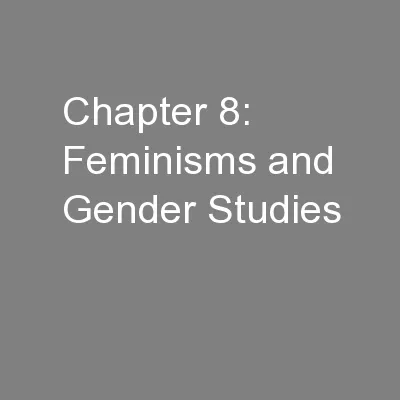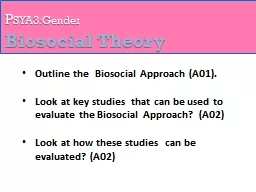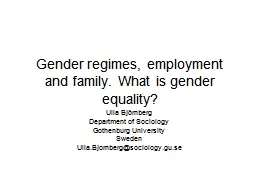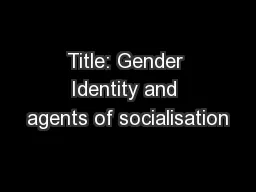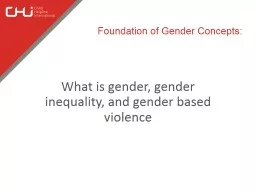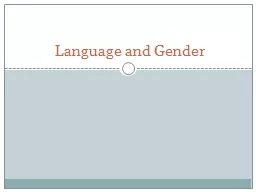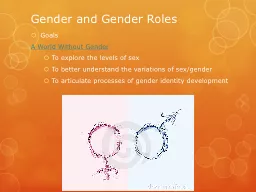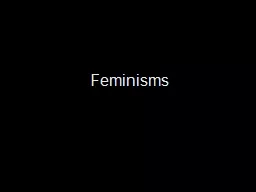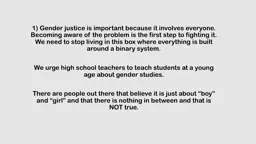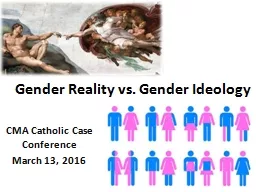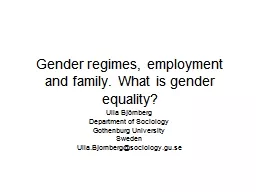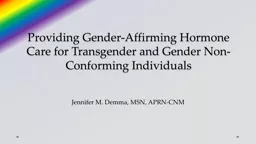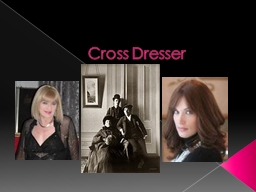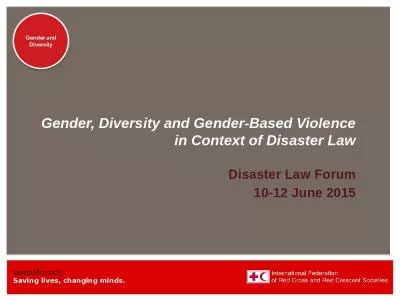PPT-Chapter 8: Feminisms and Gender Studies
Author : tatiana-dople | Published Date : 2016-05-24
A Handbook of Critical Approaches to Literature I Feminisms and Feminist Literary Criticism Definitions Patriarchal culture Feminism as a political approach like
Presentation Embed Code
Download Presentation
Download Presentation The PPT/PDF document "Chapter 8: Feminisms and Gender Studies" is the property of its rightful owner. Permission is granted to download and print the materials on this website for personal, non-commercial use only, and to display it on your personal computer provided you do not modify the materials and that you retain all copyright notices contained in the materials. By downloading content from our website, you accept the terms of this agreement.
Chapter 8: Feminisms and Gender Studies: Transcript
A Handbook of Critical Approaches to Literature I Feminisms and Feminist Literary Criticism Definitions Patriarchal culture Feminism as a political approach like Marxism There is no longer a single set of assumptions or a homogenous feminism. And 57375en 57375ere Were None meets the standard for Range of Reading and Level of Text Complexity for grade 8 Its structure pacing and universal appeal make it an appropriate reading choice for reluctant readers 57375e book also o57373ers students . Biosocial Theory . Outline the Biosocial Approach (A01).. Look at key studies that can be used to evaluate the Biosocial Approach (A02) . Look at how these studies can be evaluated (A02) . Gender behaviours? . Ulla Björnberg. Department of Sociology. Gothenburg University. Sweden . Ulla.Bjornberg@sociology.gu.se. Paid work and gender equality. Implications for gender equality is dependant on region and class. Starter:. In pairs, discuss which agents of socialisation are to blame for ‘changing traditional masculine and feminine identities’. Extension: Why? What are they doing to change gender role perception?. Foundation of Gender Concepts:. What . I. s Gender?. Gender . refers to the social differences between males and females that are learned, and though deeply rooted in every culture, are changeable over time, and have wide variations both within and between cultures. . Language and Gender is…. Language and gender. is an area of study within sociolinguistics, applied linguistics, and related fields that investigates varieties of speech associated with a particular gender, or social norms for such gendered language . Goals. A World Without Gender. To . explore the levels of sex. To . better understand the variations of sex/gender. To articulate processes of gender identity development. How Many Sexes Are There?. Genetic/chromosomal sex. First . Wave. – 19th . century. to 1950 (. basic. . rights. ). Second. . Wave. – 1960-1980 (. further. . rights. ). Third . Wave. – 1980-2008 (. queer. , race). Fourth. . Wave. – 2008-? (. We urge high school teachers to teach students at a young age about gender studies. . There are people out there that believe it is just about “boy” and “girl” and that there is nothing in between and that is NOT true.. CMA Catholic Case Conference. March 13, 2016. 2007. 2014. Feb 2016. Summer 2015. 58 Gender Options . Feb 2015. May 2012/ July 2013/ Oct 2015. Transgender at five/six/eight. 1999. March 2016. Academics. Ulla Björnberg. Department of Sociology. Gothenburg University. Sweden . Ulla.Bjornberg@sociology.gu.se. Paid work and gender equality. Implications for gender equality is dependant on region and class. Jennifer M. . Demma. , MSN, APRN-CNM. Disclosures. No disclosures or conflicts of interest. Objectives. Understand informed consent and harm reduction principles as applied to provision of gender-affirming hormone care.. Gender identity. Gender . dysphoria. Gender reassignment . (sex change). Gender transition. Intersexed. Transgender/Transsexual. Male-to-Female (MTF). Female-to-Male (FTM). Clinical Issues. Questions and . Disaster Law Forum. 10-12 June 2015. Session objectives. To provide information about the IFRC approach to Gender and Diversity Sensitivity as an analytical framework for Disaster Law. To define Gender Based Violence in the context of Disaster Law,...
Download Document
Here is the link to download the presentation.
"Chapter 8: Feminisms and Gender Studies"The content belongs to its owner. You may download and print it for personal use, without modification, and keep all copyright notices. By downloading, you agree to these terms.
Related Documents

